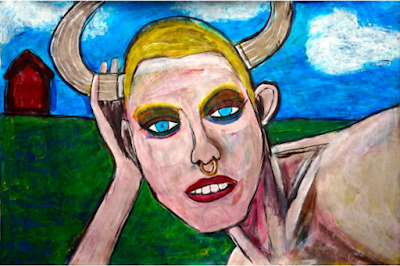Prof. Eiberg, ScienceDaily, 2008; Amber Larson, Seth Auberon (eds.), Wisdom Quarterly
 |
| ALL blue-eyed people have a common ancestor? |
A team at the University of Copenhagen has tracked down a genetic mutation that took place 6,000-10,000 years ago [founder] and is the cause of the eye color of all blue-eyed humans alive on the planet today.
What is the genetic mutation?
 |
| The historical Buddha had blue eyes. |
"But a genetic mutation affecting the OCA2 gene in our chromosomes resulted in the creation of a 'switch,' which literally 'turned off' the ability to produce brown eyes."
- In fact, ALL human eyes are brown and only appear to be other colors by the way they scatter light, including "blue" eyes
The OCA2 gene codes for the so-called P protein, which is involved in the production of melanin, the pigment that gives color to our hair, eyes, and skin.
 |
| Eye colors map of Europe (Frost/Wiki) |
The switch's effect on OCA2 is therefore very specific. If the OCA2 gene had been completely destroyed or turned off, human beings would be without melanin in their hair, eyes, or skin color [and all racial divisions would have to depend on something else] -- a condition known as albinism.
Limited genetic variation
 |
| Viking Age Buddha: Helgo Treasure |
"From this we can conclude that all blue-eyed individuals are linked to the same ancestor," says Professor Eiberg. "They have all inherited the same switch at exactly the same spot in their DNA."
Brown-eyed individuals, by contrast, have considerable individual variation in the area of their DNA that controls melanin production.
Professor Eiberg and his team examined mitochondrial DNA and compared the eye color of blue-eyed individuals in countries as diverse as Jordan, Denmark, and Turkey. His findings are the latest in a decade of genetic research, which began in 1996, when Professor Eiberg first implicated the OCA2 gene as being responsible for eye color.
Nature shuffles our genes
 |
| Does that sort of make us incestuous relatives? |
It is one of several mutations such as hair color, baldness, freckles, and beauty spots, which neither increases nor reduces a human's chance of survival. [Since by "survival" is meant the fitness to send one's genes into the future, these things do impact it.]
 |
| What about one of each? Heterochromia Iridis |
As Professor Eiberg says, "it simply shows that nature is constantly shuffling the human genome, creating a genetic cocktail of human chromosomes and trying out different changes as it does so." More
- Blue eye color in humans may be caused by a perfectly associated founder mutation in a regulatory element located within the HERC2 gene inhibiting OCA2 expression | Human Genetics (springer.com)
- Mummified feces reveals pre-Columbian cultures of the Caribbean consumed a diversity of plants [no cannibalism]











































































































































































































































No comments:
Post a Comment